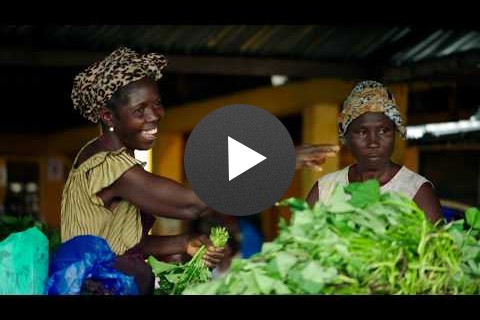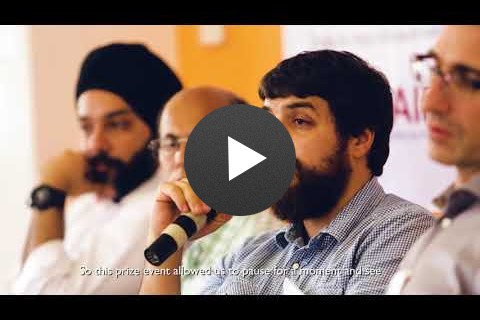USAID, through its Commercial Farm Service Program, opened six farm service centers in Oromia Region, which provide a complete range of supplies such as quality seeds, fertilizers, plant protection products, and veterinary products; information; and marketing links for Ethiopian smallholders, allowing them to make the step from subsistence to commercial production.
Developing Farm Service Centers in Ethiopia
6:50
Video Transcript
(00:16-00:22) The farm service center is very promising. I believe it is a place where we will see many good things in the future.
(00:29-00:32) A program with a positive vision for development.
(00:44-00:50) The Commercial Farm Service Program is a pilot program funded by the United States Agency for International Development …
(00:50-00:59) and implemented by CNFA, an international development organization that works worldwide on enterprise-based agricultural development initiatives.
(01:00-01:05) Building off the success in previous countries such as Afghanistan, Georgia and Moldova,
(01:05-01:13) the Commercial Farm Service Program is adapting CNFA’s private sector farm service center model to the Ethiopian context for the first time.
(01:14-01:20) One of the critically lacking elements in the production value chain of agricultural system in this country is input.
(01:22-01:31) Quality input is a problem, timely provision of input is an issue, and at the same time, price is a problem.
(01:31-01:37) Throughout the Oromia Region, the program is establishing a network of six market-oriented farm service centers …
(01:37-01:45) that provide smallholder farmers with seeds, plant protection products, fertilizer, veterinary supplies and services,
(01:45-01:53) tools and small equipment as well as training and information that will enable them to produce surpluses and become better linked to end markets.
(01:54-01:59) Because Oromia is such a vast region in Ethiopia and we are only doing six farm service centers …
(01:50-02:06) we have to select some of the areas where the program could be viable, and where the need is really very high.
(02:06-02:13) Interested entrepreneurs were invited to submit a business plan that was evaluated on technical and financial capacities …
(02:13-02:18) as well as potential for their farm service center to create a positive impact on their communities.
(02:19-02:30) For each of the six new centers, USAID dedicated a $40,000 grant to be used for branding and marketing costs, environmental mitigation, farmer outreach, and office equipment.
(02:30-02:34) But the investment into this agribusiness start-up does not end there.
(02:35-02:42) To promote buy-in and sustainability, the program required that each selected grantee “match” USAID’s investment to the dollar.
(02:42-02:51) As a result, each of the six forecasted a minimum contribution of $40,000 in the form of construction, inventory and salaries for newly created jobs.
(02:52-02:57) Out of the six, one is woman owned farm service center in Shashemane,
(02:57-03:02) two are farmers’ cooperative union and the three are owned by private entrepreneurs.
(03:03-03:10) The six farm service centers are located in Ambo, Bishoftu, Dodola, Fiche, Nekemte and Shashamane.
(03:11-03:17) Each center is equipped with a community training room, standardized agro-chemical and veterinary showrooms,
(03:17-03:24) a veterinary laboratory, environmentally sound storage facilities and offices for highly trained staff.
(03:24-03:32) All six of the centers are open and ready for business with eager customers anxiously taking advantage of the store’s benefits.
(03:32-03:41) They are one-stop-shop. Be it animal feed, fertilizer, pesticide; a training and consultative service…
(03:41-03:47) all these things the farmer can get from that shop; so they are very important.
(03:47-03:50) I have purchased many inputs from the Bishoftu Farm Service Center.
(03:50-03:57) Mostly, I bought Plant Protection Products and they’ve been very effective.
(03:57-04:02) Recently, there was an insect pest (caterpillar) that attacked our tomato crop …
(04:02-04:08) and I bought products such as tracer and coragen. Because I applied those, my tomatoes have continued to grow.
(04:09-04:12) The farmers that didn’t use these protection products suffered and their production was destroyed.
(04:12-04:16) I wasn’t affected at all and managed to harvest my crops.
(04:16-04:18) What makes the farm service center different from the other suppliers in town …
(04:18-04:23) is that it offers a wider variety of high quality inputs and medicines.
(04:23-04:31) The prices are better and much more reasonable.
(04:23-04:35) Their services are supported by experts.
(04:35-04:43) They invite us to attend a variety of trainings in collaboration with different Input wholesale companies.
(04:43-04:48) They also come to our fields and provide consultations.
(04:52-04:57) High quality inventory and customer loyalty are essential for the centers to be sustainable.
(04:57-05:04) To ensure this, the program has been forging strong relationships between the farm service centers and input wholesalers …
(05:04-05:11) who provide a timely source of quality inputs, on-site product usage trainings and access to inputs by credit.
(05:12-05:18) These business relationships are the strong foundation for a farm service center-owned wholesale company that is being developed …
(05:18-05:26) to pool inventory needs, access volume discounts and deal directly with top-tier national and international suppliers.
(05:26-05:35) Beyond input suppliers, the program’s outreach strategies also addresses the reality that women have less access to opportunities, farm goods and training.
(05:35-05:44) The program is reaching out to both men and women to ensure that they have equal access to the grant application as well as to the center’s products and services.
(05:45-05:52) This commercial farm service program looks at the input market, such an important part of increasing productivity.
(05:52-06:03) If you don’t have the inputs, veterinary and crop alike, then you are not going to get the real increases in yields or productivity that you need to increase your on farm production.
(06:03-06:08) And without that, the Feed the Future program or Agriculture Growth Program is not very viable.
(06:12-06:17) The productivity of our farmers is much much lower than even our neighbors.
(06:18-06:25) So this program can really make a change in the lives of individual farmers.
(06:25-06:30) Our ambition is to see small scale farmers or smallholder farmers to increase their productivity,
(06:30-06:36) feed themselves and their families, and live a modestly good life.















Comment
Make a general inquiry or suggest an improvement.